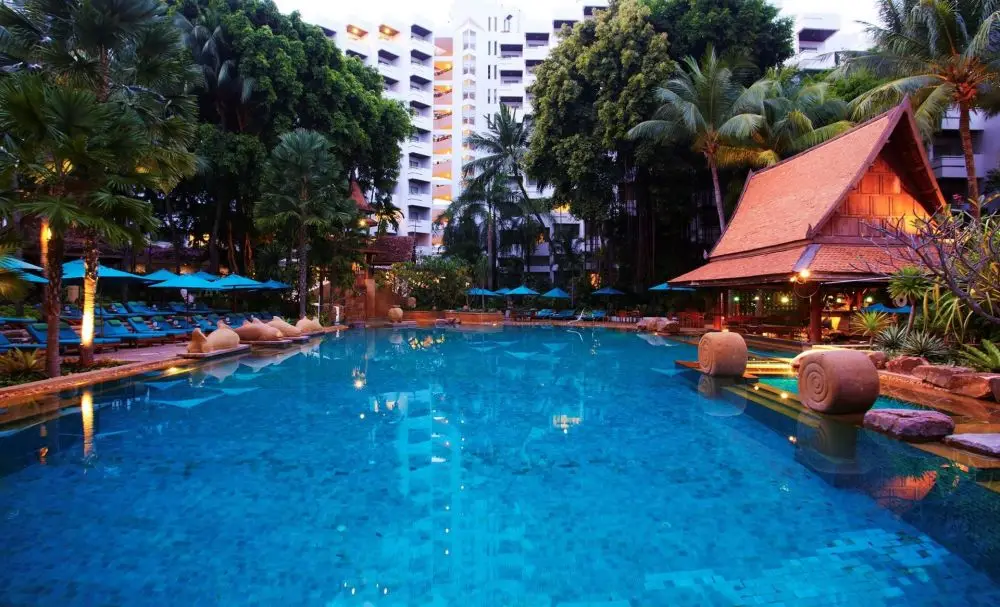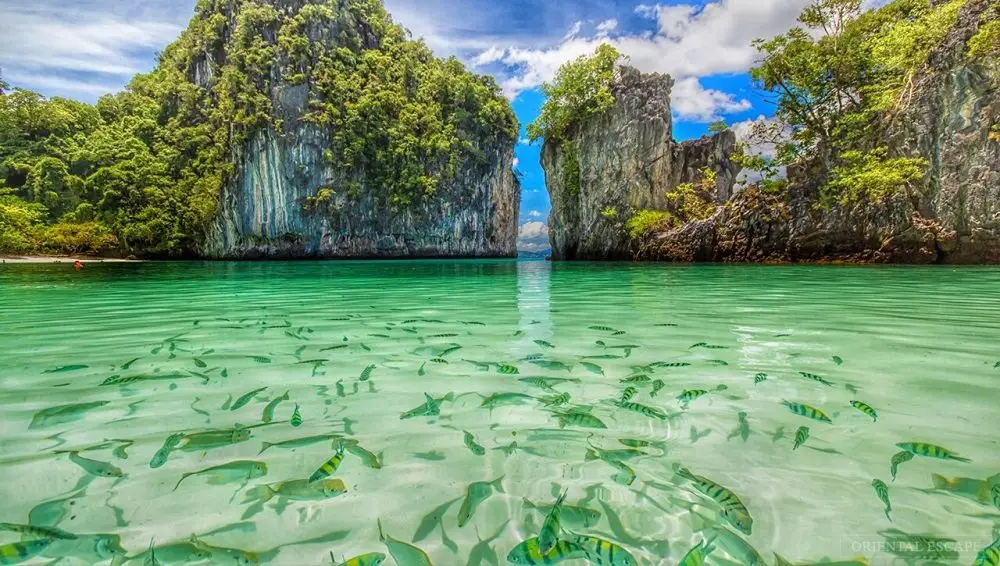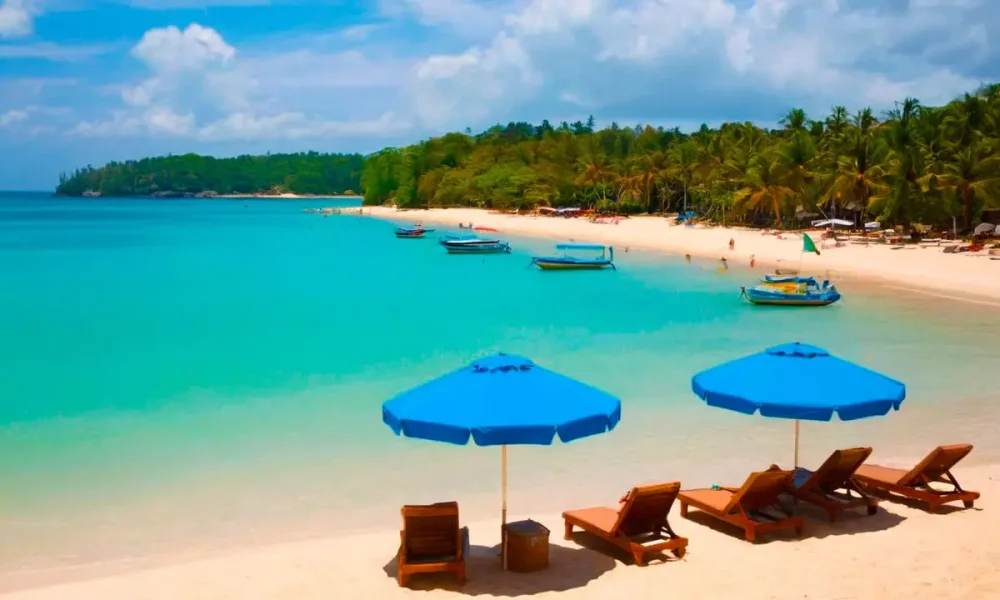Pattaya has long gone beyond a budget destination. The resort market has moved into a phase of service saturation, where not only prices but also approach compete. In 2025, the tourist is focused on the ratio of cosiness, infrastructure and rating. The choice is determined not by advertising, but by the impressions of real guests. Therefore, the 10 best hotels in Pattaya according to reviews is not just a list, but a reference point for a demanding traveller.
Centara Grand Mirage 5*: a themed paradise with a water park
This hotel has made a strong position in the list of top 10 best hotels in Pattaya by offering an aquatic complex unique to the region. The gigantic area is stylised as a lost world with tropical vegetation and decorations. Water slides, lazy river, Jacuzzi and children’s areas are not just an addition, but a full-fledged centre of attraction. Rooms are spacious, with balconies, suitable for families. Staff run daily animation activities. Direct access to the beach adds to the resort’s versatility. This format combines entertainment saturation with a high degree of comfort, which guarantees constant interest from tourists.
Royal Cliff 5*: privacy and tradition with bay views
 The complex occupies the territory of the cape and is characterised by architectural rigour. Among the 10 best hotels in Pattaya, Royal Cliff stands out for its multi-format concept: buildings for families, business guests and spa holidays are combined on a single site. The panorama of the Gulf of Thailand can be seen from all rooms. Facilities include club tennis, spa pavilions and conference areas. Restaurants offer multi-cuisine menus, including halal and vegetarian options. The complex is popular with international event organisers and family travellers who appreciate tranquillity and respectability.
The complex occupies the territory of the cape and is characterised by architectural rigour. Among the 10 best hotels in Pattaya, Royal Cliff stands out for its multi-format concept: buildings for families, business guests and spa holidays are combined on a single site. The panorama of the Gulf of Thailand can be seen from all rooms. Facilities include club tennis, spa pavilions and conference areas. Restaurants offer multi-cuisine menus, including halal and vegetarian options. The complex is popular with international event organisers and family travellers who appreciate tranquillity and respectability.
InterContinental Pattaya Resort 5*: secluded elite on the hillside
The resort is surrounded by a green area, built on a hill with a cascading arrangement of villas. Each room has a private terrace overlooking the water. The tropical area is illuminated to create a park-like effect. Special features include a private pier for boat excursions and a unique wine cellar. Breakfast includes customised and local farm-to-table cuisine. The spa area is decorated in Balinese style and is open 24 hours a day. The complex is chosen for romantic getaways and anniversaries, emphasising its image as one of the most status-conscious in the region.
Pullman Pattaya Hotel G 5*: a striking representative of the top 10 best hotels in Pattaya
White-washed interiors, beachside lounge areas and a busy evening programme create a lively rhythm. Rooms are equipped with smart home technology and each room features personalised décor. A spacious pool overlooking the bay and music parties on the beach attract a young audience and digital travellers. The location in the northern part of the city avoids the mass influx while maintaining access to key locations. The resort is ideal for those looking for an aesthetically pleasing and active holiday format.
Amari Pattaya 5*: brand stability and oriental service
As one of the top 10 hotels in Pattaya, Amari confidently maintains its reputation for high service and proven infrastructure. The complex is divided into two zones – classic and apartment, where you can stay with a kitchen. The morning menu is varied: from Asian broth to European pastries. The territory is well-maintained, the staff speaks several languages, including Russian. A swimming pool with a slide, a children’s room and a SPA zone form an offer favourable for families. The location near a lively neighbourhood gives access to restaurants and shops, while the area is safely isolated from noise.
Cape Dara Resort 5*: architecture of air and light
A contender for the title of the most visually striking of the top 10 hotels in Pattaya. The building seems to disappear into the skyline with its panoramic glazing and light-coloured finishes. Rooms have French windows and terraces. The main pool is multi-level, with waterfalls and lighting. The rooftop restaurant offers seafood tasting sets. Wellness programme combines Balinese and Korean techniques. The hotel is particularly popular with honeymooners and bloggers, thanks to its photogenic architecture and secluded location.
Grande Centre Point Pattaya 5*: leisure, shopping and water activities
The resort has strategically positioned itself among the top 10 hotels in Pattaya by combining the format of a hotel and a shopping and entertainment complex. The facility’s tower connects to the mall, water park and restaurant courtyard. On the roof there is a water park with thematic zones, including waterfalls and children’s island. Rooms are spacious, with modern facilities. A library and co-working areas allow you to combine relaxation and work. The hotel is chosen by tourists from China, South Korea and all-in-one family travellers.
Hilton Pattaya 5*: one of the 10 best hotels in Pataya
The complex is located directly above the Central Festival shopping centre. All rooms offer panoramic views of the bay. The bathrooms are separated by glass, emphasising the premium level of design. There is a rooftop Sky-bar with DJ sets and a gastronomic menu. The hotel is aimed at couples, business guests and gourmets who prefer urban-luxury without compromise.

Avani Pattaya 5*: quiet garden in the city centre
The hotel offers an eco-relaxation format against the backdrop of metropolitan dynamics. Thanks to the vast green area and low density of buildings, it is consistently ranked among the 10 best hotels in Pattaya. The rooms are decorated in Asian style: warm colours, rattan, local ceramics. The restaurant runs gastro masterclasses, and spa programmes include aromatherapy and massages with Thai-made oils. The resort is in demand among Europeans who appreciate the balance between nature and infrastructure.
Baraquda Pattaya – MGallery 5*: Art Hospitality in the Centre
A boutique hotel in style is often the first choice in selections of designer accommodation. The interiors are from a French architect’s studio, with an emphasis on light, form and individuality. Rooms are unusual: open baths, localised materials, author’s furniture. Inside is a contemporary art gallery. The rooftop bar offers night city views and signature cocktails. The hotel is suitable for artistic audiences, couples, fans of unconventional holidays.
Conclusion
 Choosing a resort complex affects the entire holiday. A well-chosen place creates the mood, saves time and shapes the impression of Thailand. In 2025, the 10 best hotels in Pattaya are not only comfort, but also adaptation to the needs of a particular guest: from family format to designer retreat. The main criterion is reviews from real travellers, because it is they who make the difference between “good” and “excellent”.
Choosing a resort complex affects the entire holiday. A well-chosen place creates the mood, saves time and shapes the impression of Thailand. In 2025, the 10 best hotels in Pattaya are not only comfort, but also adaptation to the needs of a particular guest: from family format to designer retreat. The main criterion is reviews from real travellers, because it is they who make the difference between “good” and “excellent”.

 en
en  ar
ar  de
de  es
es  fr
fr  nl
nl  hi
hi  el
el  it
it  pt
pt 



